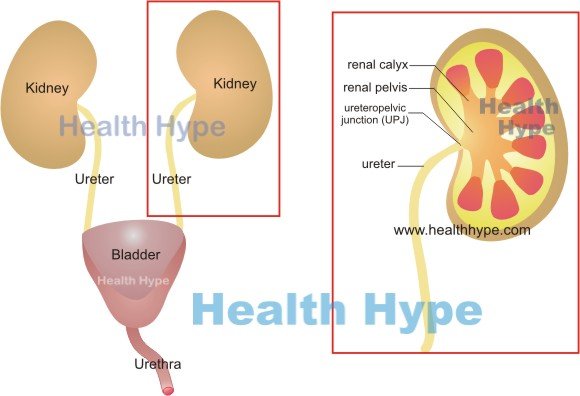Clots in Urine (Clotted Blood) Reasons and Causes
Blood in the urine (hematuria) is not uncommon but most bleeding in the urine is invisible to the naked eye. The discovery of blood during a urine dipstick test concerns most people. However, it is not always a serious problem. There may be no other symptoms as would be expected and the cause is not always easily identified. Blood clots in the urine may seem to be more serious but it is not always a major problem. The absence of pain is not a reliable indicator of whether the underlying problem of blood clots in the urine is serious or not.
Reasons for Blood Clots in Urine
A blood clot is simply a collection of blood cells and other components that form a small mass. The clotting process is an essential way of plugging any breaks in blood vessels. There are many mechanisms to prevent blood from clotting prematurely but when these fail a blood clot can form even when there is no rupture in the blood vessel. Blood usually clots when it exits a blood vessel because some of the anti-clotting mechanisms only exist within the blood vessel.
The medical term for blood in the urine is hematuria. Most of the time there is no visible sign of this blood because the bleeding is so minimal compared to the volume (microscopic hematuria). Sometimes the blood can alter the color of urine and the urine may appear entirely bloody in less common cases. There are also instances where blood clots may appear in the urine. Since clots are clumps of blood cells and semi-solid, it is more likely to cause pain as it exits the bladder. It can even obstruct the outflow of urine when large enough to block the urinary tract.

Causes of Blood Clots in Urine
Bleeding can occur anywhere from the kidney down the urinary tract. Sometimes blood from the tip of the genitalia may be passed out with urine.The reasons for blood clots is largely the same as un-clotted blood in the urine. Blood has a tendency to start clotting once it leaves a blood vessel. Visible blood clots usually indicates larger blood volume loss and may also indicate bleeding higher up in the urinary tract. However, these clots can occur even when bleeding is lower down the urinary tract.
Drugs, Diet and Toxins
There are a number of substances that can discolor the urine which may be mistaken for blood. However, some substances and particularly toxins can cause bleeding within the kidney and urinary tract.
- Foods including beets, berries, rhubarb and certain types of energy drinks.
- Supplements including high dose vitamins and minerals and certain herbal remedies.
- Prescription medication including certain types of antihypertensives, antibiotics, anticoagulants, antihistamines, antiepileptics, antipsychotics, antiretrovirals and NSAIDs.
- Toxins including heavy metals and overdosing on drugs such as acetaminophen.
Kidney and Urinary Tract Infections
Urinary tract infections (UTIs) are one of the most common causes for blood in the urine. Most are due to bacteria which enter through the urethra and rise up to the bladder or even higher. It can even reach the kidneys. It is therefore known as an ascending infection. Sometimes bacteria in the bloodstream can lodge in the kidney or urinary tract. A common source of bacteria is from the rectum but a host of bacteria can cause UTIs, including sexually transmitted infections. Most infections are limited to the bladder.
Kidney and Bladder Stones
Kidney stones form when substances within urine precipitate and eventually grows to form a mass. Small kidney stones are passed without any symptoms but larger stones can be painful, lead to bleeding and cause obstructions to urine outflow. These stones tend to travel down the ureter and reside within the bladder where it can grow in size if it is not passed out. Sometimes a stone can form and grow within the bladder especially in conditions like a bladder infection.

Trauma
Bleeding in the urine can be a sign of a kidney injury related to abdominal trauma. A blow to the upper abdomen, especially on the upper flanks or mid back, can injure the kidney despite there being no penetration of the abdominal wall. For this reason a punch in this area is called a kidney punch. It can progress to serious complications depending on the severity of the blow. Sharp force or penetrating injuries to this area can easily injure the the kidney and may rupture blood vessels which will naturally lead to bleeding and blood clots in the urine.
Systemic and Urinary Diseases
Various kidney diseases can lead to hematuria and depending on the extent of the bleeding there can be clot formation which may pass out in the urine. Some of these diseases include:
- Alport syndrome
- Immunoglobulin A (IgA) nephropathy
- Hemolytic-uremic syndrome
- Postinfectious glomerulonephritis
- Membranoproliferative glomerulonephritis
- Lupus nephritis
- Anaphylactoid purpura (Henoch-Schönlein purpura)
- Hypercalciuria/urolithiasis
- Sickle cell disease/trait
- Anatomic abnormalities (hydronephrosis, polycystic kidney disease, vascular malformations)
- Hyperuricosuria
Cancer
Malignant tumors of the kidney and urinary tract, the bladder specifically, leads to blood in the urine. Usually the bleeding is microscopic until the tumor invades a blood vessel and then there is gross blood in the urine. In other words gross bleeding is usually a sign of advanced cancer of the kidney or urinary tract. Cancer of the prostate can also cause blood in the urine.
Prostate Diseases
The urethra runs through the prostate and diseases of the prostate where bleeding occurs may lead to blood in the urine. Microscopic bleeding may occur with benign prostatic hypertrophy (BPH), where there is enlargement of the prostate with advancing age. Infectious prostatitis may present with microscopic or gross bleeding depending on the severity of the infection. As mentioned above, prostate cancer can also be the cause of hematuria.
Other Causes
- Fever – hematuria may sometimes occur with a fever even if there is no infection of the kidney or urinary tract.
- Strenuous exercise – hematuria occurs for many reasons with strenuous exercise and is usually not serious.
- Menstruation – menstrual blood can taint urine as it is being passed out although it does not stem from the urinary tract.
References
- Hematuria. Medscape
- Blood in urine. Mayo Clinic
Last updated on September 11, 2018.




